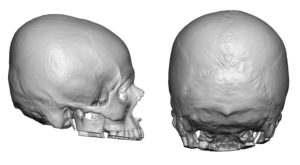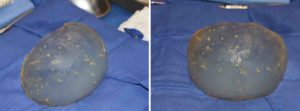Background: Skull augmentation today has evolved to augment any area of the head, whether it is the forehead, top, back or sides. This has become possible due to the use of 3D CT scans and implant designing software. This allows the implant design to be done before surgery and also permits a smaller scalp incision to be used for its placement.
The back of the head is a common aesthetic skull deformity caused by either the way the fetus was positioned in utero, the sleeping position of the infant after birth or the genetic blueprint of the skull’s development. To those patients so affected, it can be a lifelong obsession with numerous lifestyle changes to hide or camouflage the abnormal head shape.


The flat back of the head is a not uncommon aesthetic skull shape concern. Once patients realize that a single surgery of 90 minutes can satisfactorily address their skull shape concerns, patients are elated that such a corrective procedure exists. The key is the fabrication of a custom implant in which all implant shaping is done before surgery and ensures a smooth postoperative feel to the back of the head. The only caveat is that there is a limit as to how big the implant can be as the scalp must be able to stretch over it and allow the incision to be closed without undue tension.
Highlights:
- The flat back of head can present in a male with the need for a pure horizontal projection increase.
- A custom occipital skull implant can increase posterior projection in a completely horizontal direction if desired.
- How thick any custom skull implant can be is limited by how much the scalp can stretch.
Dr. Barry Eppley
Indianapolis, Indiana




